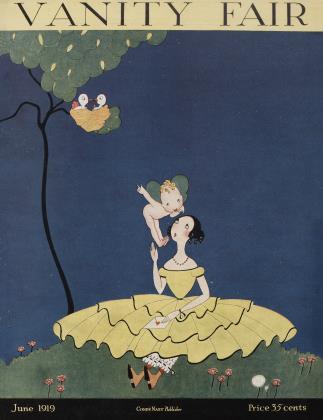Sign In to Your Account
Subscribers have complete access to the archive.
Sign In Not a Subscriber?Join NowThe Art of Dujam Penic
A Serbian Sculptor, Now in New York, Who Is Rapidly Coming Into His Own
FREDERICK JAMES GREGG
AT the present time, when Slavs of one sort or another are so much in evidence in the metropolis, the case of young Dujam Penic, now a New York sculptor, is particularly interesting. Although he is technically a Serbian, and owing allegiance to that nation, which is emerging from the Great War with bright prospects after years of suffering, he is really a Dalmatian from the neighborhood of Spalato, and so is in a very particular way a neighbor of Ivan Mestrovitz, who is the Poet Laureate in stone of the turbulent Balkans, and who was to have shown his works here a year ago, but could not, on account of the war.
Penic went to Venice when he was seventeen, and stayed in that city of light, legend and romance until he was twenty. There he studied under Ferraroni. On removing to Rome he became a pupil of Mestrovitz, working afterwards with that artist on his big "hero horse" at Agram. He then lived for a while in Vienna, after which he made his headquarters in Florence. Then, true to the traditions of sculptors all the world over, he made his way to Paris, to find out some of the artistic secrets of the French.
IT was there that he discovered the existence of a new lodestone—New York. He found that all sorts of artists were curious about this city. They thought about it with the same sort of curiosity that was displayed by opera singers, musicians, stage people, and, in fact, the whole race of persons of specialized talents. So he decided to make a voyage of exploration on his own account, arriving here just fifteen days before the first gun was fired which was to set the whole world afire.
It was not a good time for a young sculptor to land in America, even if America was doing her best, officially, to show that she had no interest, one way or another, in events that were to concern her very personally later on. Penic, however, got busy. He became an assistant to Jo Davidson, working in his studio until that sculptor was despatched to Europe to do the busts of leading chiefs of state, statesmen and generals on which he is at present engaged.
After Davidson went abroad, Penic started on his own hook in his friend's studio in Macdougal Alley. The first things that he showed here were part of an interesting exhibition. He is to have his first one man show in this country early in the Fall, at the Kingore Galleries. It must not be imagined that Penic's acquaintance with exhibitions only began recently. He showed two portraits at Agram in 1910; the head of a boy in Rome in 1911; another head at Vienna in 1912, and a couple of portraits at a show in Belgrade in 1913.
SO far as his art beliefs are concerned, he considers Mestrovitz as his master, in the sense that he has been more influenced ,by that sculptor than by any other artist with whom he has come in personal contact. At the same time he is willing to admit that the great masters whose work have appealed to him most are Giotto, Michelangelo and Rodin. It is not surprising that these are also the men who have appealed most to Mestrovitz. But Mestrovitz is perhaps first of all a patriot and, after that, an artist.
Every Slav, like every Irishman, is a natural politician. Penic, when almost a boy, and hardly yet a student, was in the National movement, which has helped to destroy Germany and Turkey. He is a great believer in Trumbich, the Slav leader in Dalmatia, and thinks that there could be nothing more reasonable in the world than that the resurrection of his race should be brought about largely by artists, much as the freedom of Poland has been helped along by an artist— Ignace Paderewski.
 View Full Issue
View Full Issue












Subscribers have complete access to the archive.
Sign In Not a Subscriber?Join Now